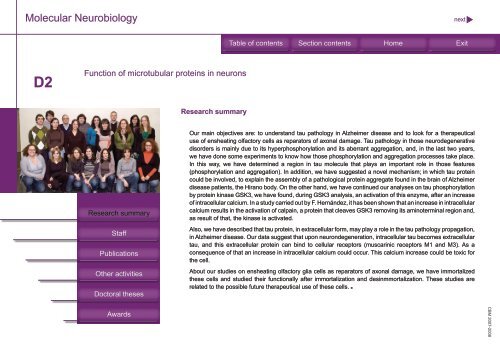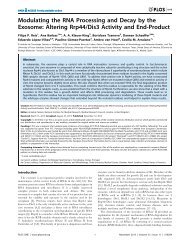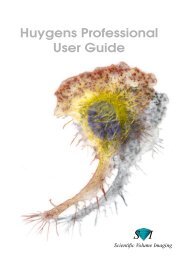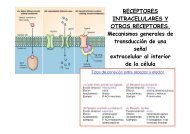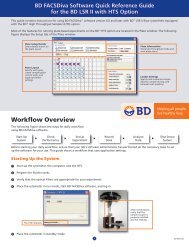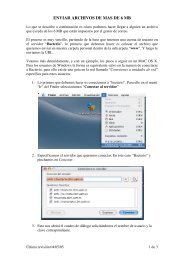Molecular Neurobiology - Universidad Autónoma de Madrid
Molecular Neurobiology - Universidad Autónoma de Madrid
Molecular Neurobiology - Universidad Autónoma de Madrid
You also want an ePaper? Increase the reach of your titles
YUMPU automatically turns print PDFs into web optimized ePapers that Google loves.
<strong>Molecular</strong> <strong>Neurobiology</strong><br />
previous next<br />
Table of contents Section contents Home Exit<br />
D2<br />
Function of microtubular proteins in neurons<br />
Research summary<br />
Research summary<br />
Staff<br />
Publications<br />
Other activities<br />
Doctoral theses<br />
Our main objectives are: to un<strong>de</strong>rstand tau pathology in Alzheimer disease and to look for a therapeutical<br />
use of ensheating olfactory cells as reparators of axonal damage. Tau pathology in those neuro<strong>de</strong>generative<br />
disor<strong>de</strong>rs is mainly due to its hyperphosphorylation and its aberrant aggregation, and, in the last two years,<br />
we have done some experiments to know how those phosphorylation and aggregation processes take place.<br />
In this way, we have <strong>de</strong>termined a region in tau molecule that plays an important role in those features<br />
(phosphorylation and aggregation). In addition, we have suggested a novel mechanism; in which tau protein<br />
could be involved, to explain the assembly of a pathological protein aggregate found in the brain of Alzheimer<br />
disease patients, the Hirano body. On the other hand, we have continued our analyses on tau phosphorylation<br />
by protein kinase GSK3, we have found, during GSK3 analysis, an activation of this enzyme, after an increase<br />
of intracellular calcium. In a study carried out by F. Hernán<strong>de</strong>z, it has been shown that an increase in intracellular<br />
calcium results in the activation of calpain, a protein that cleaves GSK3 removing its aminoterminal region and,<br />
as result of that, the kinase is activated.<br />
Also, we have <strong>de</strong>scribed that tau protein, in extracellular form, may play a role in the tau pathology propagation,<br />
in Alzheimer disease. Our data suggest that upon neuron<strong>de</strong>generation, intracellular tau becomes extracellular<br />
tau, and this extracellular protein can bind to cellular receptors (muscarinic receptors M1 and M3). As a<br />
consequence of that an increase in intracellular calcium could occur. This calcium increase could be toxic for<br />
the cell.<br />
About our studies on ensheating olfactory glia cells as reparators of axonal damage, we have immortalized<br />
these cells and studied their functionally after immortalization and <strong>de</strong>sinmmortalization. These studies are<br />
related to the possible future therapeutical use of these cells.<br />
Awards<br />
CBM 2007-2008


